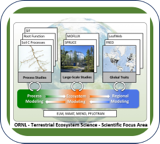The emissions task is improving understanding of fossil fuel carbon dioxide emissions, especially in terms of their temporal distribution, spatial distribution, and uncertainties associated with those emissions. Fossil emissions are a primary driver of the atmospheric disequilibrium impacting and changing terrestrial ecosystems as investigated in the other tasks of the SFA.
Since its inception, TES SFA funding has contributed to:
- Creating global emission inventories at monthly temporal resolution and national spatial resolution for use in mechanistic carbon cycle analyses,
- Examining the global and spatial distribution of emissions, and
- Calculating the evolution of global uncertainty of those emissions with time.
The calculation of emission inventories has progressed beyond preliminary estimates to operational processing of monthly data sets with annual updates achieved for emission years 2007, 2008, 2009 and 2010; emission year 2011 is in progress at the time of this writing.
Access Emissions Data
Data were initially maintained by the Carbon Dioxide Information Analysis Center (CDIAC) but were transitioned in 2018 to the U.S. Department of Energy’s (DOE) Environmental System Science Data Infrastructure for a Virtual Ecosystem (ESS-DIVE) where they continue to be freely available to the public. Global, spatial distributions of emissions have been created for both annual and monthly data sets and are available from the CDIAC Data Portal at ESS-DIVE.
Understanding Emissions Data
Andres et al. (2014) examines the evolution of uncertainty in global fossil carbon dioxide emission estimates through three different analyses and considers the unique attributes of this data set including dependent and independent data, temporal and spatial relationships, missing and filled values, and expert judgment. This was the first published, comprehensive examination of this subject in 30 years. The figure below compares the uncertainty associated with fossil fuel estimates to other major components in the global carbon cycle.
Fossil fuel carbon dioxide compared to other global carbon cycle components. One sigma uncertainty is expressed in percent of total carbon cycle flux and reservoir stock changes. 1-D dependent and 3-D are respectively the maximum and minimum uncertainty analysis results. The land use curve lies directly under the oceanic uptake curve.
Major Contributions
The emissions task has contributed to other related activities. Since SFA inception, these activities include 23 peer-reviewed publications, 2 edited works, 76 meeting abstracts, 25 technical reports, and 5 invited presentations at universities and institutes. These include a contributing authorship to “Chapter 5 Drivers, Trends and Mitigation” of the IPCC Fifth Assessment Report (Mitigation of Climate Change). That IPCC-related work continues with contributions to the ongoing Coupled Model Intercomparison Project (CMIP) 6 activities. Task personnel also continue to play a prominent role in Global Carbon Project activities, including the recently updated Global Carbon Atlas (originally released at the UNFCCC COP19 in Warsaw, Poland November 2013, and had more than 24,000 unique visits from 164 countries in the first week after release). Finally, the uncertainty emphasis is expanding to examine the uncertainty with spatially distributing emissions on a one-degree grid; this work is nearing publication and will have application to mapped emissions produced by other researchers.
Recent Publications and Data Citations
- Andres, R., Boden, T., & Higdon, D. (2014). A new evaluation of the uncertainty associated with CDIAC estimates of fossil fuel carbon dioxide emission. Tellus B, 66. doi:http://dx.doi.org/10.3402/tellusb.v66.23616
- Boden, T.A., G. Marland, and R.J. Andres. 2013. Global, Regional, and National Fossil-Fuel CO2 Emissions. Carbon Dioxide Information Analysis Center, Oak Ridge National Laboratory, U.S. Department of Energy, Oak Ridge, Tenn., U.S.A. doi 10.3334/CDIAC/00001_V2013

